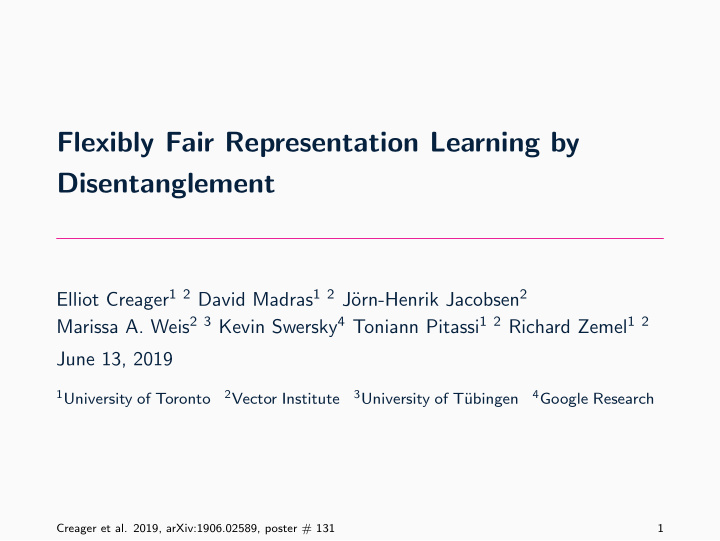



Flexibly Fair Representation Learning by Disentanglement Elliot Creager 1 2 David Madras 1 2 J¨ orn-Henrik Jacobsen 2 Marissa A. Weis 2 3 Kevin Swersky 4 Toniann Pitassi 1 2 Richard Zemel 1 2 June 13, 2019 1 University of Toronto 2 Vector Institute 3 University of T¨ 4 Google Research ubingen Creager et al. 2019, arXiv:1906.02589, poster # 131 1
Why Fair Representation Learning? g 1 Fair Representation: [ x , a ] f → z → ˆ y 1 g 2 z → ˆ y 2 g 3 z → ˆ y 3 . . . Given sensitive attribute a ∈ { 0 , 1 } , we want: • z ⊥ a (demographic parity) with z = f ( x , a ) • z maintains as much info about x as possible A fair representation acts as a group parity bottleneck Current approaches are flexible w.r.t. downstream task labels (Madras et al., 2018) but inflexible w.r.t. sensitive attributes Creager et al. 2019, arXiv:1906.02589, poster # 131 2
Further Motivation Subgroup discrimination • We would like to handle the case where a ∈ { 0 , 1 } N a is a vector of sensitive attributes • ML systems can discriminate against subgroups defined via conjunctions of sensitive attributes (Buolamwini & Gebru, 2018) Disentangled Representation Learning • Each dimension of z should correspond to no more than one semantic factor of variation (object shape, position, etc.) in the data • VAE variants encourage factorized posterior q ( z | x ) (Higgins et al., 2017) or aggregate posterior q ( z ) (Kim & Mnih, 2018; Chen et al., 2018) Creager et al. 2019, arXiv:1906.02589, poster # 131 3 (Kim & Mnih, 2018)
Flexibly Fair VAE Data flow at train time (left) and test time (right) for FFVAE Latent Code Modification Desiderata • To achieve DP w.r.t. some a i , use • z ⊥ b j ∀ j [ z , b ] \ b i • b i ⊥ b j ∀ i � = j • To achieve DP w.r.t. conjunction of binary attributes a i ∧ a j ∧ a k , • MutualInfo( a j , b j ) is large ∀ j use [ z , b ] \{ b i , b j , b k } Creager et al. 2019, arXiv:1906.02589, poster # 131 4
Flexibly Fair VAE Data flow at train time (left) and test time (right) for FFVAE Learning Objective � L FFVAE ( p , q ) = E q ( z , b | x ) [log p ( x | z , b ) + α log p ( a j | b j )] j � − γ D KL ( q ( z , b ) || q ( z ) q ( b j )) j − D KL [ q ( z , b | x ) || p ( z , b )] α encourages predictiveness in the latent code; γ encourages disentanglement Creager et al. 2019, arXiv:1906.02589, poster # 131 5
Results - Synthetic Data DSpritesUnfair Samples Figure: With correlated factors of variation, a fair classification task is predicting Shape without discriminating against XPosition 1.00 1.00 1.00 1.00 FFVAE FFVAE FactorVAE FactorVAE 0.95 0.95 0.95 0.95 CVAE CVAE -VAE -VAE 0.90 0.90 0.90 0.90 Accuracy Accuracy Accuracy Accuracy MLP MLP 0.85 0.85 0.85 0.85 0.80 FFVAE FFVAE 0.80 0.80 0.80 FactorVAE FactorVAE 0.75 0.75 CVAE CVAE 0.75 0.75 -VAE -VAE 0.70 0.70 MLP 0.70 MLP 0.70 0.0000 0.0005 0.0010 0.0015 0.0020 0.0025 0.00 0.05 0.10 0.15 0.20 0.25 0.30 0.00 0.01 0.02 0.03 0.04 0.05 0.06 0.07 0.00 0.05 0.10 0.15 0.20 0.25 DP DP DP DP a = Scale a = Shape a =Shape ∧ Scale a =Shape ∨ Scale Figure: Pareto-fronts showing fairness-accuracy tradeoff curves, DSpritesUnfair dataset. Optimal point is top left corner (perfect accuracy, no unfairness). y = XPosition. ∆ DP � | E [ˆ y = 1 | a = 1] − E [ˆ y = 1 | a = 0] | with ˆ y ∈ { 0 , 1 } Creager et al. 2019, arXiv:1906.02589, poster # 131 6
Results - Tabular and Image Data Celeb-A Communities & Crime 0.825 0.825 FFVAE FFVAE 0.85 0.84 0.800 0.800 -VAE -VAE 0.775 0.775 0.80 0.82 Accuracy Accuracy Accuracy 0.750 Accuracy 0.750 0.80 0.75 0.725 0.725 0.78 0.700 0.700 FFVAE FFVAE 0.70 0.675 0.675 FactorVAE 0.76 FactorVAE CVAE CVAE 0.650 0.650 -VAE -VAE 0.65 0.74 0.625 0.625 0.00 0.05 0.10 0.15 0.20 0.25 0.30 0.35 0.40 0.00 0.05 0.10 0.15 0.20 0.25 0.30 0.35 0.40 0.0 0.1 0.2 0.3 0.4 0.5 0.6 0.00 0.02 0.04 0.06 0.08 0.10 0.12 0.14 0.16 DP DP DP DP typical success: typical failure: typical success: typical failure: a = R ∧ P a = R ∨ B a = ¬ E ∧ M a = C ∧ M • Neighborhood-level population • Over 200 , 000 images of celebrity statistics: 120 features for 1 , 994 faces, each associated with 40 neighborhoods binary attributes (OvalFace, HeavyMakeup, etc.) • We choose racePctBlack (R), blackPerCap (B), and • We choose Chubby (C), Eyeglasses pctNotSpeakEnglWell (P) as (E) and Male (M) as sensitive sensitive attributes attributes • Held-out label • Held-out label y = violentCrimesPerCapita y = HeavyMakeup (H) Creager et al. 2019, arXiv:1906.02589, poster # 131 7
Conclusion • FFVAE enables flexibly fair downstream classification by disentangling information from multiple sensitive attributes • Future work: extending to other group fairness definitions, and studying robustness of disentangled/fair representation learners to distribution shift • Visit us at poster # 131 tonight! Creager et al. 2019, arXiv:1906.02589, poster # 131 8
Recommend
More recommend